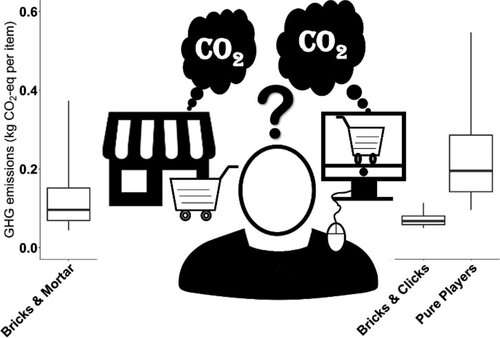Comparing greenhouse gas footprints of online versus traditional shopping

When consumers are trying to decide between traditional and online shopping, many factors come into play, such as price, quality, convenience and timeframe. Now, thanks to new research reported in ACS' Environmental Science & Technology, eco-conscious consumers could have another consideration: greenhouse gas emissions. In the study, researchers estimated that shopping at brick-and-mortar stores for personal and home care products often produces less greenhouse gas than one type of online shopping, but more than another.
Fast-moving consumer goods, such as toiletries, cleaning supplies and packaged foods, are low-priced products that sell quickly and are purchased frequently. Although shoppers have traditionally bought these items at "Bricks & Mortar" (physical retail) stores, online sales are increasing in many countries, including China, the U.K. and the U.S. Among online shopping models, the two main types are "Bricks & Clicks" (online ordering, followed by home delivery directly from a physical store) and "Pure Play" (online ordering, with fulfillment via a parcel delivery company). Sadegh Shahmohammadi, Mark Huijbregts and colleagues wanted to systematically characterize and compare the greenhouse gas footprints of these three shopping practices.
The researchers estimated total greenhouse gas emissions associated with the three shopping methods for fast-moving consumer goods purchased in the U.K. Included in the three models were emissions from transport, warehouse storage, delivery and packaging. The analysis revealed that total greenhouse gas footprints per item purchased of Bricks & Mortar were higher than those of Bricks & Clicks in 63% of the shopping events and lower than those of Pure Players in 81% of shopping events.
The study also identified ways that consumers and retailers could reduce their greenhouse gas emissions for each type of shopping. For example, Bricks & Mortar shoppers could reduce their footprint by 40% by walking or biking to stores, and Pure Players could cut emissions by 26% by switching from vans to electric cargo bikes for the delivery of products from parcel distribution centers to consumers' homes.
More information: Sadegh Shahmohammadi et al. Comparative Greenhouse Gas Footprinting of Online versus Traditional Shopping for Fast-Moving Consumer Goods: A Stochastic Approach, Environmental Science & Technology (2020). DOI: 10.1021/acs.est.9b06252
Journal information: Environmental Science & Technology
Provided by American Chemical Society

















